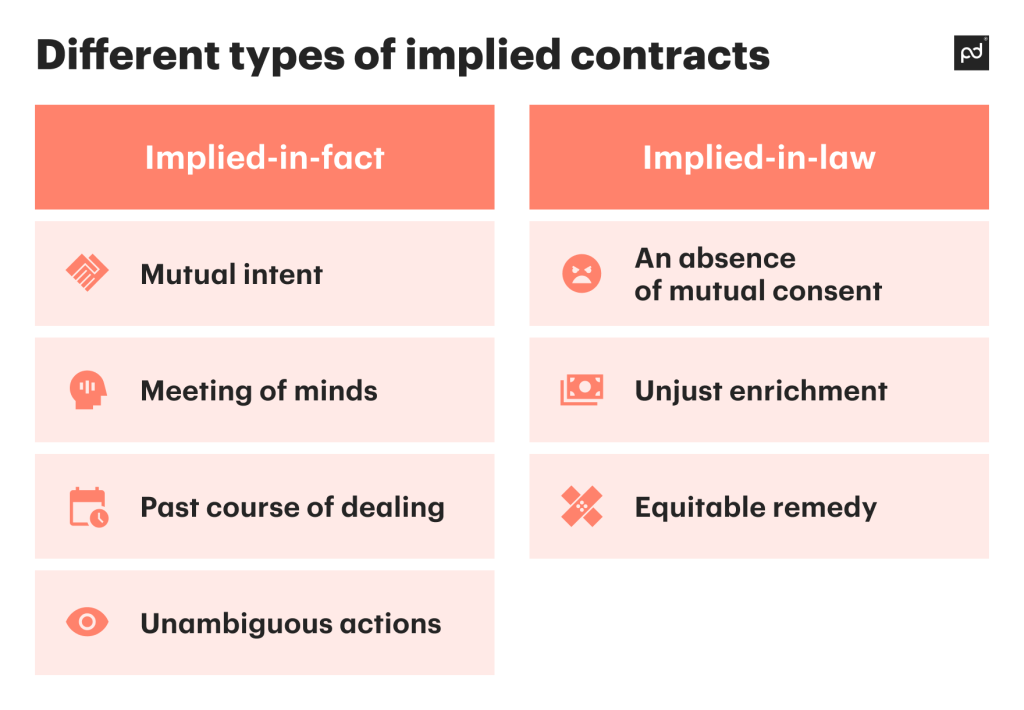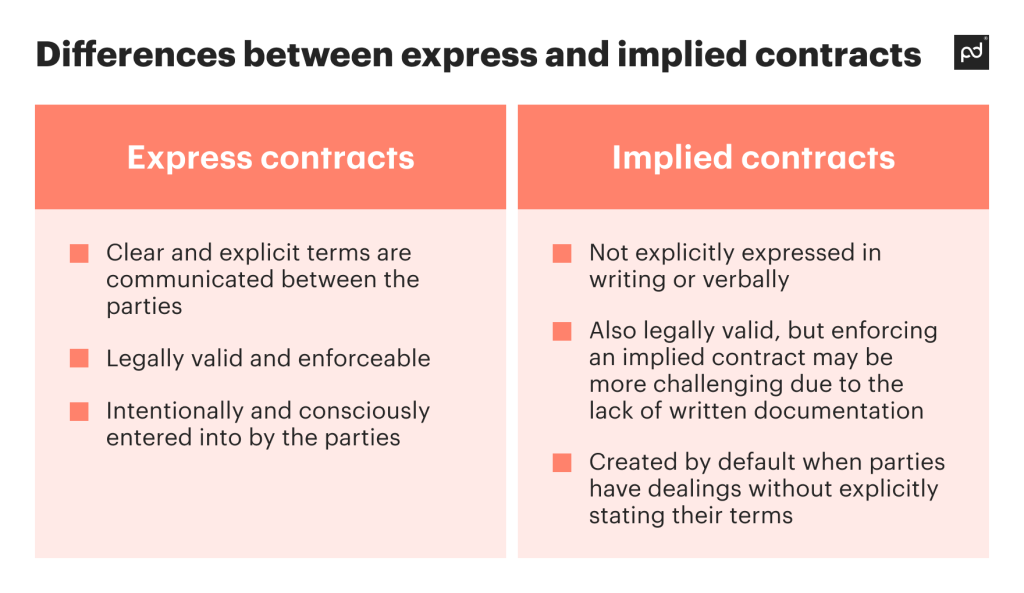Did you know you can enter a contract without actually saying a word?
That’s right: implied contracts hold more power than you might think!
In this article, you’ll learn what implied contracts are and how they’re formed, along with discovering some useful knowledge on how to enforce them (or prevent them from forming in the first place).
Key takeaways:
- Implied contracts can arise without express written or verbal consent.
- Your actions and behavior are what determine the existence of an implied contract.
- Implied contracts can be enforced in the same way as an express contract.
- Preventing an implied contract from forming is easy with contract management software.
What is an implied contract?
The concept of implied contracts is pretty confusing for lawyers, let alone a layperson with a limited understanding of the law.
Even Googling ‘What is an implied contract’ will return a long list of results, with conflicting information depending on the jurisdiction and year of publication.
Luckily, we’re here to clear things up with an up-to-date implied contract definition: at the most basic level, an implied contract is a legally binding agreement that creates a contractual obligation between two or more parties.
Unlike an express contract, which is explicitly stated either verbally or in writing and has clear terms and conditions, an implied contract arises from the conduct and actions of the parties involved.
But if that’s the case, and implied contracts aren’t written or spoken, then how are they formed?
Well, generally speaking, the following constituent criteria must be met:
Conduct or behavior
The implied contract is based on the actions and behavior of each party, which must indicate that there’s a mutual understanding and an intention to be bound by a contract.
Mutual intent
Both parties must also demonstrate mutual intent, even though the contract isn’t explicitly discussed or written down.
NB: Remember how we said, “generally speaking”? Well, there are instances where an implied contract can be enforced without mutual intent. More on that later…
Reasonable inference
The existence of the implied contract can be inferred from the circumstances and interactions between the parties and is based on what a reasonable person would assume under similar circumstances.
Further general criteria must also be met for a contract to be considered legally binding:
Offer
One party must make a clear and definite proposal to enter into a contract with the other. The offer sets out the terms and conditions of the contract.
Acceptance
The other party must unambiguously agree to the offer made, demonstrating their willingness to be bound by the terms presented.
Consideration
A valid contract requires some form of consideration, too i.e. something of value exchanged between the parties.
This usually takes the form of one party paying money and the other providing goods or services.
Capacity
Both parties must have the legal capacity to enter into a contract.
This means they must be of sound mind and legal age (usually 18 years old or older).
Legal purpose
The purpose of the contract must be lawful and not against public policy.
Contracts with illegal objectives are not enforceable.
Genuine consent
Both parties must enter into the contract willingly and without duress, fraud, or misrepresentation.
So, now we know what an implied contract is and how it can be formed.
What are the different types of implied contracts?
There are two categories of legally distinct implied contracts that you should know about.

Implied-in-fact
An implied-in-fact contract is one that arises from the conduct, actions, or circumstances of the parties involved.
Key characteristics of implied-in-fact contracts include:
Mutual intent
Both parties must demonstrate their intent to be bound by the contract through their actions or behavior (this is a common feature of service contracts).
For instance, imagine if you were to enter a coffee shop, order a latte, and watch as the barista prepares your coffee.
In this case, an implied-in-fact contract will have arisen, and you’d be expected to pay for the latte.
Meeting of minds
Implied-in-fact contracts require what the courts call a “meeting of minds” too, meaning both parties understand and agree to the terms of the contract even without giving explicit verbal or written agreement.
Past course of dealing
Sometimes, these contracts are based on previous dealings or established patterns of behavior between the parties.
For example, if a person has routinely paid for lawn-mowing services in the past, the expectation to pay for this continues to exist even if it’s not discussed every time.
Unambiguous actions
The actions or conduct of the parties must be clear and unambiguous to infer the existence of a contract.
If there’s any uncertainty surrounding the parties’ intentions, it may not be considered an implied-in-fact contract.
Implied-in-law
An implied-in-law contract, also known as a quasi-contract, may be created by a court when no formal contract exists.
Unlike implied-in-fact contracts, they’re not based on the parties’ behavior or mutual intent but rather on the principles of fairness and equity.
Key characteristics of implied-in-law contracts include:
An absence of mutual consent
Unlike implied-in-fact contracts, implied-in-law contracts aren’t formed by the parties consent. Instead, the court imposes them to prevent one party from unfairly benefiting at the expense of the other.
Unjust enrichment
The primary rationale for implied-in-law contracts is that they prevent one party from being unjustly enriched at the expense of the other.
The court thus steps in to ensure fairness and restitution.
Equitable remedy
Implied-in-law contracts aren’t actual contracts; they’re a legal remedy provided by a court to restore fairness when a true contract is lacking.
If you’re wondering why courts initially created this ‘legal fiction’, you’re in for a fun history lesson!
It turns out these common law principles of equity weren’t developed by legal courts at all but by separately established courts of equity in medieval England.
Some US states (such as New Jersey) still uphold this distinction between courts of law and equity.
How do you enforce an implied contract?
Enforcing an implied contract is simple on paper.
However, in reality, the legal process can be lengthy and expensive for both parties.
As such, disagreements are usually settled out of court, either through direct conversations or intermediary lawyers.
If you want to go about enforcing an implied contract, you should follow this process:
- Gather evidence. Collect any relevant documents, communications, or records that support the existence and terms of the implied contract.
- Demonstrate mutual intent. Show that both parties had a mutual understanding and intention to be bound by the implied contract.
- Prove reasonable inference. Provide evidence that the contract’s existence can be reasonably inferred from the parties’ conduct, actions, or circumstances.
- Seek legal advice. Consult with an attorney to assess the validity and enforceability of the implied contract and explore available legal options.
- Initiate legal action. If necessary, file a lawsuit in a court of law to enforce the implied contract and seek appropriate remedies or damages.
Express vs. implied contract
The express vs implied contract distinction should hopefully be clearer at this stage, but let’s run through their similarities and differences nonetheless.
Similarities between express and implied contracts
- Both are legally binding agreements.
- Both require mutual intent to form a contract.
- Both involve offer, acceptance, and consideration as key elements.
- Both can be enforced in a court of law in case of breach of contract.
Differences between express and implied contracts

The form of agreement
The most significant difference is that an implied contract is not explicitly expressed in writing or verbally, whereas an express contract has clear and explicit terms communicated between the parties.
Enforceability
Both implied and express contracts are legally valid and enforceable.
However, enforcing an implied contract may be more challenging due to the lack of written documentation, which can make it harder to prove the terms of the agreement in case of disputes.
Clarity of terms
In an express contract, the terms and conditions are specifically laid out, leaving no room for ambiguity or misinterpretation.
In contrast, an implied contract relies on reasonable inferences and may not have precisely defined terms.
Formation
Express contracts are intentionally and consciously entered into by the parties, while implied contracts are often created by default when parties have dealings without explicitly stating their terms.
Implied contract example
To better illustrate the points we’ve covered above, let’s now wrap up by including an example of an implied contract.
Example: Repairing a broken fence
Imagine you have a neighbor, John, who has a broken fence that separates your properties.
One day, you notice some of your livestock have been wandering onto his property because of it.
Concerned about the situation, you decide to take action and repair the fence.
- Conduct or behavior. You go over to John’s property with the necessary tools and materials to fix the fence without explicitly discussing any terms or payment for the repair.
- Mutual intent. Your actions in repairing the fence demonstrate your intention to remedy the situation and ensure the fence is fixed. Meanwhile, John observes your efforts to repair the fence, implying that he accepts your help.
- Reasonable inference. A reasonable person in this situation would assume that by fixing the fence, you expect to be compensated for your time, effort, and the cost of the materials used. Likewise, John would reasonably understand that he needs to compensate you for the repair.
Through your conduct and John’s passive acceptance of your assistance, an implied-in-fact contract may be formed.
This implies that you will provide the service of repairing the fence, and John will compensate you for it.
If John refuses to pay you for the repair work, you could potentially take legal action to enforce the implied contract.
Although the contract wasn’t explicitly discussed or written down, the courts may recognize the implied agreement based on your actions and the circumstances surrounding the repair.
Let PandaDoc help you with all your contract needs
In conclusion, implied contracts can be a tricky area of law to navigate since they focus on deriving meaning, intention, and obligation from actions rather than a verbal or written agreement.
Luckily, PandaDoc’s contract management software removes the need for you to face this uncertainty in a business setting.
With customizable contract templates and a library of pre-approved clause choices, you can build error-free contracts in minutes, saving valuable time and effort.
Plus, a centralized document repository simplifies organization and retrieval, keeping all parties on the same page during contract discussions.
The best part?
Our contract management tool is just one part of our comprehensive document workflow software, which could save your business significant amounts of time and money on managing your manual processes.
Why not get started with PandaDoc today?
Frequently asked questions
-
The elements necessary to establish an implied contract are:
- Conduct or behavior. Parties must demonstrate mutual understanding and intention to be bound by their actions and behavior.
- Mutual intent. Both parties must implicitly agree to enter into the contract, even though it’s not explicitly discussed or written down.
- Reasonable inference. The existence of the implied contract is inferrable from what a reasonable person would assume under similar circumstances.
-
To avoid an implied contract, individuals should be cautious regarding their actions and communications to prevent any unintentional formation of contractual obligations.
Be clear in expressing your intentions, refrain from accepting benefits without clarity, and use written contracts to outline terms explicitly. Specify non-binding agreements when discussing business matters and seek legal advice when uncertain to ensure you understand the potential for contract formation.
Disclaimer
PandaDoc is not a law firm, or a substitute for an attorney or law firm. This page is not intended to and does not provide legal advice. Should you have legal questions on the validity of e-signatures or digital signatures and the enforceability thereof, please consult with an attorney or law firm. Use of PandaDocs services are governed by our Terms of Use and Privacy Policy.


